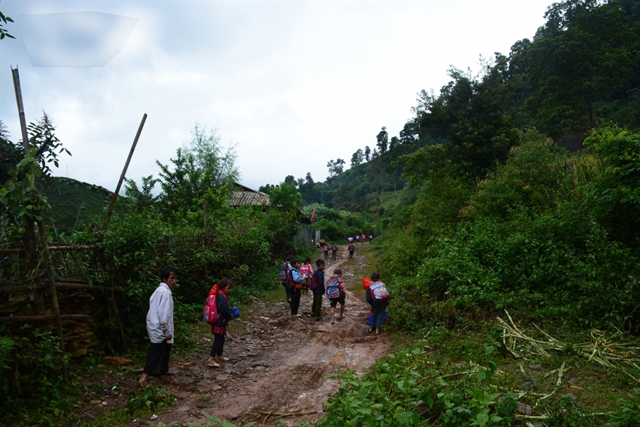 Society
Society

It’s hard for people to believe that kindergarten students must walk up to six kilometres to go get to school, but that is what students in the Ón Village do on a daily basis.

|
| Kindergarten students in Ón Village must walk up to six kilometres to get to school. — Photo vov.vn |
THANH HÓA — It’s hard for people to believe that kindergarten students must walk up to six kilometres to go get to school, but that is what students in the Ón Village do on a daily basis.
Often they are so tired when they reach school that they immediately fall asleep.
The Ón Village is in Tam Chung Commune, Mường Lát District in the central province of Thanh Hóa.
It’s nearly 230km from Thanh Hóa City’s centre to Mường Lát District, and it’s about 25km from the district to the Ón Village. Many of the roads aren't suitable even for motorbikes, especially on rainy days.
The Ón Village kindergarten is in the middle of a high mountain. It is about 2km from the border marker of Laos and Sơn La Province.
Vi Thị Bột teaches a class of 16 four-year-old students. On heavy rainy days, only three or four students make it to school.
“They live too far away and are not taken to school by their parents. They cannot get here in in heavy rain,” said Bột.
Bột said that the school lacks the infrastructure and the necessary equipment to supply lunch for students.
“After studying hours, some of them go back home, others go to their relatives nearby and some others bring lunch from home and wait for afternoon lesson after the nap,” she said.
The Ón Village has three teachers. Besides Bột, there are Phạm Thị Giang and Bùi Thị Thúy.
Recalling her first days at the school, Thúy knew in advance it would be miserable, but it's much harder than even she anticipated.
Teachers can try to overcome difficulties, but for students who are only three or four years old, Thúy struggles to believe they can help enough.
Students often enter school at 7.30 am, so they must start their journey at about 5 am. Three-year-old students also walk to school, and even walk for 5-6km, said Thúy.
Education to escape early marriage
The Ón Village has 112 households of ethnic Mông minorities. It is considered one of the poorest areas in Thanh Hóa Province.
Local residents’ meals are maize, cassava and bamboo found in the fields or in the forest.
Due to poverty, teenagers quitting school to get married at only 13-15 years old is not unusual. They then have many children, and these children too fall into poverty and are illiterate. The circle repeats through generations.
Teacher Vi Văn Chuân, head of the Ón Village’s primary school, said, “They are too tired after walking for a long way, so many days they are not able to listen in class.”
The weather is too hot in summer and too cold in winter, which also affects their health.
However, through education, they are literate, have fun and the cycle of early marriage and poverty can be broken, he said.
Giàng A Chống, Secretary of the Ón Village Party Committee, was the first person in the village to graduate from high school, and also the first person to be a Party member.
Giàng is a pioneer in poverty and illiteracy elimination in the village.
Chống believes that students must go to school despite every obstacle as it is the only way to escape from poverty and early marriage.
“If students quit school, teachers do not hesitate to come to their houses and encourage them to come back. In order to eliminate poverty, the first work is to eliminate illiteracy,” said Chống.
Students do not just learn to read and write, but also learn how to grow rice and raise livestock effectively, he said.
Chống’s and generations of teachers’ efforts have gradually come true.
Thanks to the authorities and sponsors, in 2018, strong classrooms were built in the village.
Miracle
Nguyễn Thế Cường, Deputy Principal of the Tam Chung Primary School, said that in Ón Village, students attending school should be considered a miracle.
The miracle did not come naturally. It is thanks to the effort and determination of village officials and generations of teachers.
Teachers like Bột or Quách Thị Minh, all sacrificed their youth, carefully preparing lessons to bring students in this mountainous region knowledge.
In recent years, more and more students from the Ón Village go to junior secondary school and high school.
Teacher Minh said that in some families, all four children have entered high school. Some of them have gone to Hà Nội for higher-level education, with the hope of coming back to enlighten the village. — VNS




